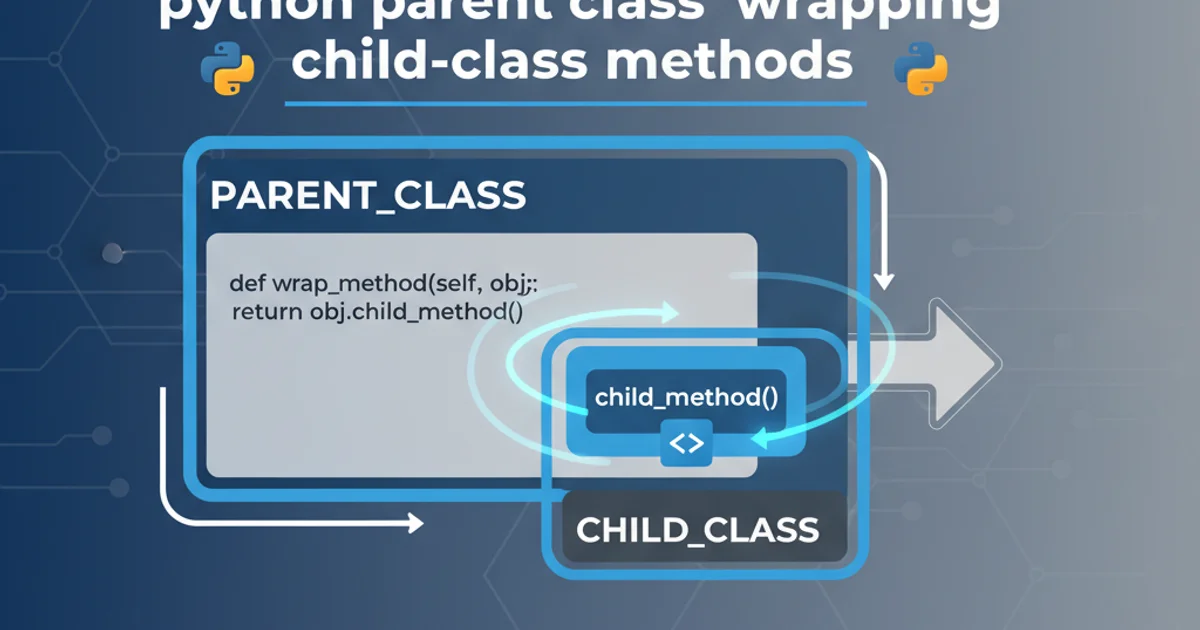python parent class 'wrapping' child-class methods
Categories:
Python Inheritance: 'Wrapping' Child Class Methods with Parent Logic

Explore effective strategies for extending or modifying child class method behavior from a parent class in Python, using inheritance, decorators, and method overriding patterns.
In object-oriented programming with Python, inheritance allows a child class to inherit attributes and methods from a parent class. A common requirement arises when you want to 'wrap' or augment a child class's method with additional logic defined in the parent class, without directly modifying the child's implementation. This article delves into various techniques to achieve this, providing flexibility and maintaining a clean separation of concerns.
The Challenge: Augmenting Child Methods from the Parent
Consider a scenario where a base class defines a common structure or logging mechanism, and derived classes implement specific functionalities. You might want the parent class to automatically apply pre- or post-processing logic around a child's method execution. Directly calling super().method() within the child is the standard way to extend, but what if the parent needs to initiate this 'wrapping' behavior?
classDiagram
class Parent {
+wrap_child_method()
}
class Child {
+specific_action()
}
Parent <|-- Child : inherits
Parent --o Child : 'wraps' methodConceptual diagram of parent-child relationship with method wrapping.
Strategy 1: Parent-Defined Wrapper Method
One straightforward approach is for the parent class to define a method that explicitly calls a child-implemented method, adding its own logic around it. The child class then implements the specific method that the parent's wrapper invokes.
class Parent:
def execute_child_action(self):
print("Parent: Pre-processing logic")
self.specific_action()
print("Parent: Post-processing logic")
def specific_action(self):
# This method is expected to be overridden by children
raise NotImplementedError("Children must implement specific_action")
class Child(Parent):
def specific_action(self):
print("Child: Performing specific action")
# Usage
child_instance = Child()
child_instance.execute_child_action()
Parent class defining a wrapper method that calls a child-implemented method.
Strategy 2: Using a Decorator in the Parent Class
Python decorators provide a powerful way to wrap functions or methods. A parent class can define a decorator that its child classes can then apply to their methods. This allows the parent to inject logic without directly calling the child's method from within its own methods, offering more flexibility.
import functools
class Parent:
@classmethod
def parent_wrapper(cls, func):
@functools.wraps(func)
def wrapper(self, *args, **kwargs):
print("Parent Decorator: Before child method")
result = func(self, *args, **kwargs)
print("Parent Decorator: After child method")
return result
return wrapper
class Child(Parent):
@Parent.parent_wrapper
def specific_task(self, data):
print(f"Child: Processing data: {data}")
return f"Processed: {data}"
# Usage
child_instance = Child()
result = child_instance.specific_task("important info")
print(f"Result: {result}")
Parent class defining a decorator for child methods.
@classmethod decorator on parent_wrapper allows it to be called directly on the Parent class (e.g., Parent.parent_wrapper), making it accessible to child classes without needing an instance.Strategy 3: Metaclasses for Automatic Wrapping
For more advanced scenarios where you want to automatically wrap certain methods in child classes without requiring explicit decorator application, metaclasses can be used. A metaclass can inspect the class definition during its creation and modify methods as needed.
import functools
def auto_wrap(func):
@functools.wraps(func)
def wrapper(self, *args, **kwargs):
print(f"Metaclass Wrapper: Before '{func.__name__}'")
result = func(self, *args, **kwargs)
print(f"Metaclass Wrapper: After '{func.__name__}'")
return result
return wrapper
class AutoWrapMeta(type):
def __new__(mcs, name, bases, attrs):
for attr_name, attr_value in attrs.items():
if callable(attr_value) and not attr_name.startswith('__'):
# Example: Wrap all non-dunder methods
attrs[attr_name] = auto_wrap(attr_value)
return super().__new__(mcs, name, bases, attrs)
class BaseWithAutoWrap(metaclass=AutoWrapMeta):
pass
class MyService(BaseWithAutoWrap):
def process_data(self, item):
print(f"MyService: Processing item: {item}")
return f"Processed: {item}"
def log_event(self, event):
print(f"MyService: Logging event: {event}")
# Usage
service = MyService()
service.process_data("report.pdf")
service.log_event("user_login")
Using a metaclass to automatically wrap methods in derived classes.
Choosing the Right Approach
The best strategy depends on your specific needs:
- Parent-Defined Wrapper Method: Ideal for simple cases where the parent controls the execution flow and expects children to fill in specific steps (Template Method pattern).
- Decorator in Parent Class: Provides more flexibility, allowing children to selectively apply the wrapping logic to their methods. Good for adding common behaviors like logging, caching, or permission checks.
- Metaclasses: Suitable for enforcing architectural patterns or applying broad, automatic modifications to methods across an entire class hierarchy. This is the most intrusive but also the most powerful for consistent behavior.
1. Identify the wrapping requirement
Determine if the parent needs to add pre/post logic, or if it's a cross-cutting concern for multiple child methods.
2. Select a strategy
Choose between a direct parent wrapper, a parent-defined decorator, or a metaclass based on the level of automation and control required.
3. Implement the parent logic
Write the wrapping logic within the parent method, decorator, or metaclass.
4. Integrate with child classes
Ensure child classes either implement the expected method (for direct wrapping), apply the decorator, or inherit from the metaclass-enabled base class.
5. Test thoroughly
Verify that the wrapping logic correctly modifies or augments the child method's behavior without introducing side effects.